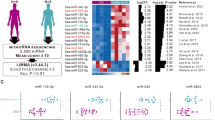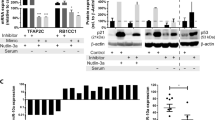Abstract
The p53 mutation in chronic myeloid leukemia (CML) led to decreased overall survival and therapy resistance which was also closely correlated with the downstream proto-oncogenes BCL-2, TCL-1 and MCL-1. We in this study aimed to investigate the function of miR130a in p53 tumor suppressor signaling pathway. We performed microRNA (miRNA) expression profile analysis in CML cancer stem cells of 38 cases and extracted total RNA from peripheral blood of 143 cases. Standard curves of U6 and miRNA were made from 10-fold serial dilutions of the cDNA, which were quantified using real-time quantitative PCR with SYBR Green by ABI 7300. The p53 mutations and BCR/ABL mutation status analysis in CML patients were detected by PCR and direct sequencing. Candidate targets of miR130a of putative relevance in CML pathogenesis were analyzed by bioinformatics approach. We then used dual-luciferase activity assay to verify the target genes of miR130a and used western blot analysis to elucidate the mechanism of miR130a on modulating drug resistance. The levels of miR-130a expression in CML were significantly lower in poor prognostic subgroups, defined by prognostic factors including mutated BCR/ABL status, p53 and ATM deletions and p53 mutations. Furthermore, underexpression of miR-130a was significantly associated with shorter overall survival and treatment-free survival in CML patients. We demonstrated that miR130a function as tumor suppressors by inhibiting multiple anti-apoptosis proteins, including BCL-2, MCL-1 and XIAP. This was a direct effect because miR130a negatively regulated expression of a BCL-2/MCL-1/XIAP 3’untranslated region-based reporter construct. Transfection of miR130a mimics into CML cells from 30 patients without p53 aberrations led to significant increases in apoptosis compared with transfection with the miRNA control. Besides, enforced expression of miR130a had no significant drug-sensitization effect in CML cells from p53-attenuated patients. MiR-130a may have an important role in the pathogenesis of CML and may be useful for assessing prognosis in patients with CML. Moreover, miR130a may provide a possible therapeutic avenue and a sensitive indicator of the activity of the p53 in CML.
This is a preview of subscription content, access via your institution
Access options
Subscribe to this journal
Receive 12 print issues and online access
$259.00 per year
only $21.58 per issue
Buy this article
- Purchase on Springer Link
- Instant access to full article PDF
Prices may be subject to local taxes which are calculated during checkout






Similar content being viewed by others
Change history
09 December 2022
This article has been retracted. Please see the Retraction Notice for more detail: https://doi.org/10.1038/s41417-022-00573-z
References
Cai J, Wu G, Tan X, Han Y, Chen C, Li C et al. Transferred BCR/ABL DNA from K562 extracellular vesicles causes chronic myeloid leukemia in immunodeficient mice. PLoS One 2014; 9: e105200.
Joshi D, Chandrakala S, Korgaonkar S, Ghosh K, Vundinti BR . Down-regulation of miR-199b associated with imatinib drug resistance in 9q34.1 deleted BCR/ABL positive CML patients. Gene 2014; 542: 109–112.
Nishioka C, Ikezoe T, Yang J, Nobumoto A, Tsuda M, Yokoyama A . Downregulation of miR-217 correlates with resistance of Ph(+) leukemia cells to ABL tyrosine kinase inhibitors. Cancer Sci 2014; 105: 297–307.
Karimiani EG, Marriage F, Merritt AJ, Burthem J, Byers RJ, Day PJ . Single-cell analysis of K562 cells: an imatinib-resistant subpopulation is adherent and has upregulated expression of BCR-ABL mRNA and protein. Exp Hematol 2014; 42: 183–191, e5.
Shibuta T, Honda E, Shiotsu H, Tanaka Y, Vellasamy S, Shiratsuchi M et al. Imatinib induces demethylation of miR-203 gene: an epigenetic mechanism of anti-tumor effect of imatinib. Leuk Res 2013; 37: 1278–1286.
Hamerschlak N, Souza CD, Cornacchioni AL, Pasquini R, Tabak D, Spector N et al. Patients' perceptions about diagnosis and treatment of chronic myeloid leukemia: a cross-sectional study among Brazilian patients. Sao Paulo Med J 2014; 65: 276–283.
Eichelser C, Stückrath I, Müller V, Milde-Langosch K, Wikman H, Pantel K et al. Increased serum levels of circulating exosomal microRNA-373 in receptor-negative breast cancer patients. Oncotarget 2014; 5: 9650–9663.
Zhang M, Luo W, Huang B, Liu Z, Sun L, Zhang Q et al. Overexpression of JAM-A in non-small cell lung cancer correlates with tumor progression. PLoS One 2013; 8: e79173.
Xishan Z, Xianjun L, Ziying L, Guangxin C, Gang L . The malignancy suppression role of miR-23a by targeting the BCR/ABL oncogene in chromic myeloid leukemia. Cancer Gene Ther 2014; 21: 397–404.
Zhang J, Wang P, Zhu J, Wang W, Yin J, Zhang C et al. SPARC expression is negatively correlated with clinicopathological factors of gastric cancer and inhibits malignancy of gastric cancer cells. Oncol Rep 2014; 31: 2312–2320.
Bubnovskaya L, Kovelskaya A, Gumenyuk L, Ganusevich I, Mamontova L, Mikhailenko V et al. Disseminated tumor cells in bone marrow of gastric cancer patients: correlation with tumor hypoxia and clinical relevance. J Oncol 2014; 2014: 582140.
Chen X, Shi X, Zhao C, Li X, Lan X, Liu S et al. Anti-rheumatic agent auranofin induced apoptosis in chronic myeloid leukemia cells resistant to imatinib through both Bcr/Abl-dependent and -independent mechanisms. Oncotarget 2014; 5: 9118–9132.
Shibazaki M, Sumi M, Takeda W, Kirihara T, Kurihara T, Sato K et al. Therapy-related chronic myelogenous leukemia following RFM therapy in a patient with follicular lymphoma. Rinsho Ketsueki 2014; 55: 970–974.
Wei S, Wang Y, Chai Q, Fang Q, Zhang Y, Lu Y et al. Over-expression of heme oxygenase-1 in peripheral blood predicts the progression and relapse risk of chronic myeloid leukemia. Chin Med J (Engl) 2014; 127: 2795–2801.
Cai J, Wu G, Tan X, Han Y, Chen C, Li C et al. Transferred BCR/ABL DNA from K562 extracellular vesicles causes chronic myeloid leukemia in immunodeficient mice. PLoS One 2014; 9: e105200.
Rondanin R, Simoni D, Romagnoli R, Baruchello R, Marchetti P, Costantini C et al. Inhibition of activated STAT5 in Bcr/Abl expressing leukemia cells with new pimozide derivatives. Bioorg Med Chem Lett 2014; 24: 4568–4574.
Li Y, Yuan Y, Tao K, Wang X, Xiao Q, Huang Z et al. Inhibition of BCR/ABL protein expression by miR-203 sensitizes for imatinib mesylate. PLoS One 2013; 8: e61858.
Li Y, Wang H, Tao K, Xiao Q, Huang Z, Zhong L et al. miR-29b suppresses CML cell proliferation and induces apoptosis via regulation of BCR/ABL1 protein. Exp Cell Res 2013; 319: 1094–1101.
Verma M, Karimiani EG, Byers RJ, Rehman S, Westerhoff HV, Day PJ . Mathematical modelling of miRNA mediated BCR.ABL protein regulation in chronic myeloid leukaemia vis-a-vis therapeutic strategies. Integr Biol (Camb) 2013; 5: 543–554.
Xishan Z, Xu Z, Lawei Y, Gang L . Hemangioblastic characteristics of cancer stem cells in chronic myeloid leukemia. Clin Lab 2012; 58: 607–613.
Liu Y, Song Y, Ma W, Zheng W, Yin H . Decreased microRNA-30a levels are associated with enhanced ABL1 and BCR-ABL1 expression in chronic myeloid leukemia. Leuk Res 2013; 37: 349–356.
Xu C, Fu H, Gao L, Wang L, Wang W, Li J et al. BCR-ABL/GATA1/miR-138 mini circuitry contributes to the leukemogenesis of chronic myeloid leukemia. Oncogene 2014; 33: 44–54.
Fei J, Li Y, Zhu X, Luo X . miR-181a post-transcriptionally downregulates oncogenic RalA and contributes to growth inhibition and apoptosis in chronic myelogenous leukemia (CML). PLoS One 2012; 7: e32834.
Lopotová T, Záčková M, Klamová H, Moravcová J . MicroRNA-451 in chronic myeloid leukemia: miR-451-BCR-ABL regulatory loop? Leuk Res 2011; 35: 974–977.
Pellicano F, Sinclair A, Holyoake TL . In search of CML stem cells' deadly weakness. Curr Hematol Malig Rep 2011; 6: 82–87.
Perrotti D, Harb JG . BCR-ABL1 kinase-dependent alteration of mRNA metabolism: potential alternatives for therapeutic intervention. Leuk Lymphoma 2011; 52: 30–44.
Hussein K, Büsche G, Muth M, Göhring G, Kreipe H, Bock O . Expression of myelopoiesis-associated microRNA in bone marrow cells of atypical chronic myeloid leukaemia and chronic myelomonocytic leukaemia. Ann Hematol 2011; 90: 307–313.
Eiring AM, Harb JG, Neviani P, Garton C, Oaks JJ, Spizzo R et al. miR-328 functions as an RNA decoy to modulate hnRNP E2 regulation of mRNA translation in leukemic blasts. Cell 2010; 140: 652–665.
Tiribelli M, Latagliata R, Luciano L, Castagnetti F, Gozzini A, Cambrin GR et al. Impact of BCR-ABL mutations on response to dasatinib after imatinib failure in elderly patients with chronic-phase chronic myeloid leukemia. Ann Hematol 2013; 92: 179–183.
Cheng A M, Byrom MW, Shelton J, Ford LP . Antisense inhibition of human miRNAs and indications for an involvement of miRNA in cell growth and apoptosis. Nucleic Acids Res 2005; 33: 1290–1297.
Mansfield JH, Harfe BD, Nissen R, Obenauer J, Srineel J, Chaudhuri A et al. MicroRNA-responsive 'sensor' transgenes uncover Hox-like and other developmentally regulated patterns of vertebrate microRNA expression. Nat Genet 2004; 36: 1079–1083.
Felli N, Fontana L, Pelosi E, Botta R, Bonci D, Facchiano F et al. MicroRNAs 221 and 222 inhibit normal erythropoiesis and erythroleukemic cell growth via kit receptor down-modulation. Proc Natl Acad Sci USA 2005; 102: 18081–18086.
Karaayvaz M, Zhai H, Ju J . miR-129 promotes apoptosis and enhances chemosensitivity to 5-fluorouracil in colorectal cancer. Cell Death Dis 2013; 4: e659.
Zhang J, Zhang D, Wu GQ, Feng ZY, Zhu SM . Propofol inhibits the adhesion of hepatocellular carcinoma cells by upregulating microRNA-199a and downregulating MMP-9 expression. Hepatobiliary Pancreat Dis Int 2013; 12: 305–309.
Ma D, Tao X, Gao F, Fan C, Wu D . miR-224 functions as an onco-miRNA in hepatocellular carcinoma cells by activating AKT signaling. Oncol Lett 2012; 4: 483–488.
Goedeke L, Vales-Lara FM, Fenstermaker M, Cirera-Salinas D, Chamorro-Jorganes A, Ramírez CM et al. A regulatory role for microRNA 33* in controlling lipid metabolism gene expression. Mol Cell Biol 2013; 33: 2339–2352.
Cheng C, Li W, Zhang Z, Yoshimura S, Hao Q, Zhang C et al. MicroRNA-144 is regulated by activator protein-1 (AP-1) and decreases expression of Alzheimer disease-related a disintegrin and metalloprotease 10 (ADAM10). J Biol Chem 2013; 288: 13748–13761.
Kiriakidou M, Nelson PT, Kouranov A, Fitziev P, Bouyioukos C, Mourelatos Z et al. A combined computational experimental approach predicts human microRNA targets. Genes Dev 2004; 18: 1165–1178.
Krek A . Combinatorial microRNA target predictions. Nature Genet 2005; 37: 495–500.
Grun D, Wang Y, Langenberger D, Gunsalus KC, Rajewsky N . microRNA Target predictions across seven Drosophila species and comparison to mammalian targets. PLoS Comput Biol 2005; 1: e13.
Miska EA, Alvarez-Saavedra E, Townsend M, Yoshii A, Sestan N, Rakic P et al. Microarray analysis of microRNA expression in the developing mammalian brain. Genome Biol 2004; 5: R68.
Sun Y, Koo S, White N, Peralta E, Esau C, Dean NM et al. Development of a micro-array to detect human and mouse microRNAs and characterization of expression in human organs. Nucleic Acids Res 2004; 32: e188.
Teichler S, Illmer T, Roemhild J, Ovcharenko D, Stiewe T, Neubauer A . MicroRNA29a regulates the expression of the nuclear oncogene Ski. Blood 2011; 118: 1899–1902.
Krichevsky AM, King KS, Donahue CP, Khrapko K, Kosik KS . A microRNA array reveals extensive regulation of microRNAs during brain development. RNA 2003; 9: 1274–1281.
Bruchova H, Borovanova T, Klamova H, Brdicka R . Gene expression profiling in chronic myeloid leukemia patients treated with hydroxyurea. Leuk Lymphoma 2002; 43: 1289–1295.
Acknowledgements
This work was funded by National Basic Research Program of China (973 Program) under Grant No. 2011CB707700 and Beijing nova program under Grant No. Z131107000413041.
Author information
Authors and Affiliations
Corresponding author
Ethics declarations
Competing interests
The authors declare no conflict of interest.
About this article
Cite this article
Zhu, X., Zhao, H., Lin, Z. et al. RETRACTED ARTICLE: Functional studies of miR-130a on the inhibitory pathways of apoptosis in patients with chronic myeloid leukemia. Cancer Gene Ther 22, 573–580 (2015). https://doi.org/10.1038/cgt.2015.50
Received:
Revised:
Accepted:
Published:
Issue Date:
DOI: https://doi.org/10.1038/cgt.2015.50
This article is cited by
-
Role of non-coding RNA networks in leukemia progression, metastasis and drug resistance
Molecular Cancer (2020)
-
Complex role of miR-130a-3p and miR-148a-3p balance on drug resistance and tumor biology in esophageal squamous cell carcinoma
Scientific Reports (2018)
-
Anti-leukemic activity of microRNA-26a in a chronic lymphocytic leukemia mouse model
Oncogene (2017)
-
Clinical significance of microRNAs in chronic and acute human leukemia
Molecular Cancer (2016)
-
MiR-130b inhibits proliferation and induces apoptosis of gastric cancer cells via CYLD
Tumor Biology (2016)



